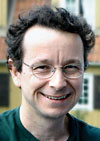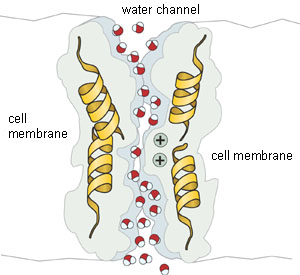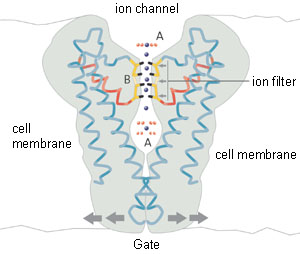This year’s Nobel Prize for Chemistry has a distinctly biological theme. Peter Agre (54) of the Johns Hopkins University School of Medicine in Baltimore, Maryland and Roderick MacKinnon (47) of the Howard Hughes Medical Institute, Rockefeller University, New York share the 10 million Swedish Kroner (about £790,000) prize money for their independent work on cell channels. The two research threads have helped explain the flow of ions and water in and out of cells in bacteria, plants, and animals and are providing new insights and approaches to human disease.
A problem that faced scientists from the middle of the nineteenth century was to explain how cells in living tissues maintain an even pressure. Somehow, water molecules must be able to pass in and out through the cell wall, but if this were a purely passive process, osmotic pressure would either lead to the cell bursting or the cell dehydrating depending on the concentration of salts on either side of the cell membrane.

Peter Agre
It was not until around 1990 that Agre’s team serendipitously discovered the first water channel – aquaporin. Like so much else in the living cell, it was all about a protein. What was perhaps obvious almost from the start was there must be some kind of valve system built into the cell but the nature of this was unimaginable until well into the twentieth century. By the mid-1950s, it was discovered that water was rapidly transported in and out of cells through a system of pores that would admit only water molecules and no other chemical species, such as ions. The pores were somehow able to filter out the ions and let billions of water molecules pass each way as required.
It was not until the late 1980s that protein science had matured to the point where the nature of this molecular machinery might be revealed. Agre had at that time studied numerous membrane proteins from red blood cells and found one of those present in kidney cells. He sequenced the peptide components of the protein and identified the DNA sequence corresponding to this protein. He was curious to know whether this might be the elusive protein that formed the cell’s water channels.

Roderick MacKinnon
In a seminal experiment he tested his idea by comparing the behaviour of cells carrying the protein and those replicated without it. When the cells were placed in water, those with the protein quickly absorbed water by osmosis and swelled up. Those without the protein remained unchanged. Agre also synthesised artificial cells, liposomes, which are like sub-microscopic soap bubbles. If he implanted the protein into the liposomes, they became permeable to water and swelled just like the real cells.

The passage of water molecules through the aquaporin (AQP1) water channel identified by Agre
Water molecules are not the only entities that pass into and out of the cell. In order to communicate cells must transfer an electrochemically produced signal in the form of ions or small molecules. The idea had first been posited by the 1909 Nobel chemist Wilhelm Ostwald in 1890. He suggested that the electrical signals measured in living tissue were perhaps produced by ions moving in and out of the cell. The idea was rapidly adopted and today we know that the cellular transport of ions leads to chemical cascades that cause muscles to contract, eyes to water, and brain cells to talk to each other. British scientists Alan Hodgkin and Andrew Huxley demonstrated that it was potassium and sodium ions that were involved in this process in their Nobel Prize winning work of the 1950s. During the 1970s it had been shown that the ion channels were able to filter ions. Of particular interest was the discovery of a channel that could admit potassium but not sodium ions.

The ion channel described by MacKinnon permits passage of potassium ions but not sodium ions
A decade after Agre’s work, in 1998, MacKinnon astounded the research world by successfully determining the atom-by-atom crystal structure of the cell membrane channels that transport potassium. The discovery was particularly astounding because several research groups had tried and failed while MacKinnon, whose scientific career started only after he quit medicine at the age of 30, took up the crystallographic challenge.
While Agre’s and MacKinnon’s findings are of fundamental importance in our understanding of life, it is the medical consequences that will have the greatest impact. There are numerous diseases attributed to dysfunctional water and ion channels – from cataracts, kidney problems, cardiovascular disease, and brain oedema to dehydration, sensitivity to heat, and cholera.
An alternative view of the discovery of water channels is taken by Romanian scientist Gheorghe Benga in a recent review, Birth of water channel proteins – the aquaporins.
Further reading
Roderick MacKinnon
http://www.rockefeller.edu/pubinfo/profilemackinnon.html
1909 Nobel laureate Ostwald
http://nobelprize.org/nobel_prizes/chemistry/laureates/1909/
1963 Nobel laureates for medicine
http://nobelprize.org/nobel_prizes/medicine/laureates/1963/
Benga’s recent paper on aquaporins
http://dx.doi.org/10.1016/S1065-6995(03)00171-9